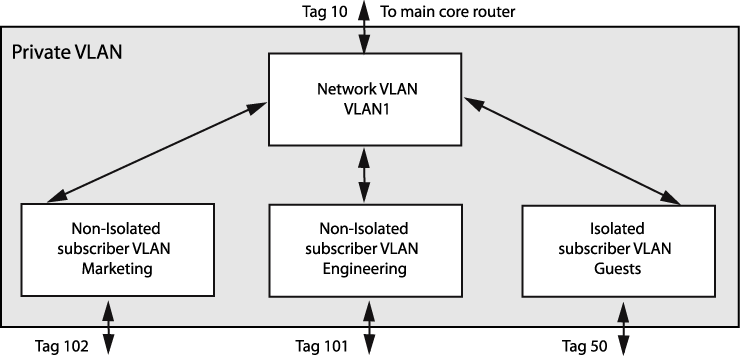Private VLAN Switch Components shows the logical components that support PVLAN configuration in a switch.

There is one network VLAN (Virtual LAN) in each PVLAN. Ports within a network VLAN, called network ports, can communicate with all VLAN ports in the PVLAN. Network devices that connect to the network VLAN ports are considered to be on the network side of the switch.

Note
PVLAN network-tagged packets are allowed to ingress on subscriber VLAN ports.Tag translation within the PVLAN is managed at the egress ports. To enable tag translation for uplink traffic from the subscriber VLANs, you must enable tag translation on the appropriate network VLAN port. Tag translation is automatically enabled on subscriber VLAN egress ports when the subscriber VLAN is created and the port is added to the VLAN as tagged. Egress traffic from a subscriber VLAN is always tagged with the subscriber VLAN tag when the port is configured as tagged.
A non-isolated subscriber VLAN is basically a standard VLAN that can participate in tag translation through the network VLAN when VLAN translation is enabled on the network VLAN port.
You can choose to not translate tags on a network VLAN port, but this is generally used only for extending a PVLAN to another switch. A non-isolated subscriber VLAN that does not use tag translation is functionally equivalent to a regular VLAN, so it is better to create non-isolated VLANs only when you plan to use tag translation.
Ports in a non-isolated VLAN can communicate with other ports in the same VLAN, ports in the network VLAN, and destinations on the network side of the switch. As with standard VLANs, non-isolated ports cannot communicate through Layer 2 with ports in other subscriber VLANs.
In Private VLAN Switch Components, the Engineering and Marketing VLANs are configured as non-isolated subscriber VLANs, which means that they act just like traditional VLANs, and they can participate in tag translation when VLAN translation is enabled on a network VLAN port that leads to network side location.
VLAN isolation within the PVLAN is established by configuring a VLAN to be an isolated subscriber VLAN and adding ports to the isolated VLAN. Unlike normal VLANs, ports in an isolated VLAN cannot communicate with other ports in the same VLAN over Layer 2 or Layer 3. The ports in an isolated VLAN can, however, communicate with Layer 2 devices on the network side of the PVLAN through the network VLAN. When the network VLAN egress port is configured for tag translation, isolated VLAN ports also participate in uplink tag translation. When isolated subscriber VLAN ports are configured as tagged, egress packets are tagged with the isolated VLAN tag. As with standard VLANs and non-isolated VLANs, isolated ports cannot communicate through Layer 2 with ports in other subscriber VLANs.

 Print
this page
Print
this page Email this topic
Email this topic Feedback
Feedback